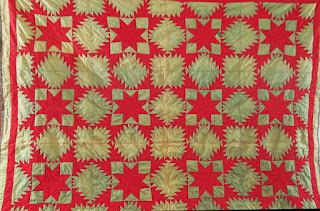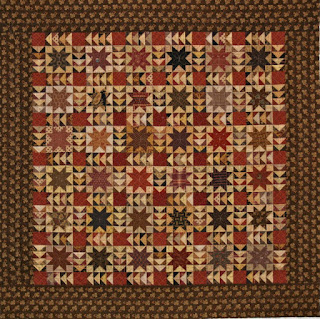Quilt pieced of homespun clothing by
Ann Sloan Lowrie Knox
The North Carolina Museum of History has in its collection a quilt made of fabrics believed to be home dyed and home woven.
These plaids, stripes and solid fabrics, usually of wool yarns
crossed with cotton, were called linseys.
According to family tradition, the quilt is made of pieces of shirts worn by boys in the Lowrie/Knox family, several of whom died in the Confederate Army. The cloth, according to the family story, was homespun and dyed with walnuts and chinaberries.
On the reverse: a post-War plaid, perhaps factory woven.
Ann Sloan, born in Mecklenburg County, North Carolina, in 1808, married twice. With her first husband Robert B. Lowrie she had two sons Robert and Samuel J. Lowrie. After his death she married widower Samuel Buie Knox (1798-1875) in 1836.
With Samuel she had nine more children between 1837 and 1849---4 girls and 5 boys. The family lived in the Steele Creek community, now a part of Charlotte. Of Ann's seven sons, six joined Confederate units.
Many of Ann's family are buried at the
Steele Creek Presbyterian Church
Steele Creek Presbyterian Church
Sons James, John and Joseph who died in 1864 and 1865 are remembered on a single gravestone.
Joseph died at 18 at Petersburg, Virginia, where he is buried. John, 24 years old, died a few weeks earlier and is buried in Staunton, Virginia. James, 38 years old, died at home in the last days of the Civil War from his wounds.
Attorney Samuel J. joined the Confederate Navy (the county history informs us he was too heavy for the cavalry). He survived the War, although he died in 1870 at the age of forty.
Steele Creek was an early Scots-Irish community.
The cemetery is known for its 18th-century headstones.
Robert Lowrie was paroled at Appomattox Court House when the war ended. He died four years later at 37. William Harrison Knox survived the war, but suffered from his wounds until his death in 1919. The only boy who did not fight was the youngest Charles Pettus Knox, about 12 when the war began. Ann Knox died in 1884, survived by just two of her sons.
Her quilt is similar to other post-War quilts of mixed wool/cotton/linen fabrics, often made to save cloth that held memories of the War. The four-patch with its butternut yellow border might have been made any time between the last days of the Civil War and Ann's death two decades later. Such quilts are hard to date because the fabrics are difficult to date.
http://ncpedia.org/quilting-part-ii-civil-war-reconstruction
[This link isn't working. We may have overwhelmed it. Try this one:
http://collections.ncdcr.gov/RediscoveryProficioPublicSearch/SearchResults.aspx?knox&&quilt
Read a post I wrote a few months ago about similar linsey quilts here:
http://civilwarquilts.blogspot.com/2015/02/confederate-quilts.html
The Knox Family Papers are in the J. Murrey Atkins Library Special Collections, University of North Carolina at Charlotte. Click here to read a summary:http://collections.ncdcr.gov/RediscoveryProficioPublicSearch/SearchResults.aspx?knox&&quilt
Read a post I wrote a few months ago about similar linsey quilts here:
http://civilwarquilts.blogspot.com/2015/02/confederate-quilts.html










































































